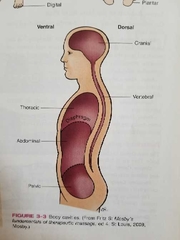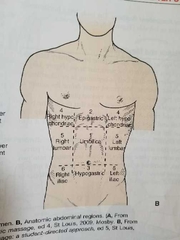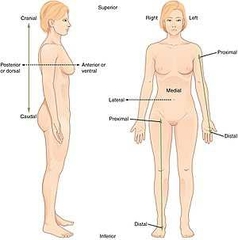![]()
![]()
![]()
Use LEFT and RIGHT arrow keys to navigate between flashcards;
Use UP and DOWN arrow keys to flip the card;
H to show hint;
A reads text to speech;
85 Cards in this Set
- Front
- Back
- 3rd side (hint)
|
Word elements |
Prefix, root, suffix, combining vowel (o, i) |
4 elements |
|
|
POMR |
problem oriented medical record |
|
|
|
SOAP |
Subjective, objective, analysis, plan |
|
|
|
2 main body cavities |

Dorsal and ventral |
|
|
|
Otic |
Ear |
|
|
|
Buccal |
Cheeks, mouth |
|
|
|
Mental |
Chin |
|
|
|
Axillary |
Armpit |
|
|
|
Coxal |
Hip |
|
|
|
Inguinal |
Groin |
|
|
|
Femoral |
Thigh |
|
|
|
Patellar |
Knee |
|
|
|
Crural |
Leg |
|
|
|
Tarsal |
Ankle |
|
|
|
Orbital |
Eye |
|
|
|
Frontal |
Forehead |
|
|
|
Cephalic |
Head |
|
|
|
Brachial |
Arm |
|
|
|
Antecubital |
Inside of elbow |
|
|
|
Antebrachial |
Forearm |
|
|
|
Carpal |
Wrist |
|
|
|
Palmer |
Hand |
|
|
|
Digital |
Fingers and toes |
|
|
|
Peroneal |
Side of leg |
|
|
|
Cubital |
Elbow |
|
|
|
Parietal |
Skull |
|
|
|
Occipital |
Base of skull |
|
|
|
Acromial |
Point of shoulder |
|
|
|
Cervical |
Neck |
|
|
|
Popliteal |
Back of knee |
|
|
|
Sural |
Calf |
|
|
|
Calcaneal |
Heel |
|
|
|
Plantar |
Sole of Foot |
|
|
|
Pedal |
Foot |
|
|
|
Soma, somato |
The body (as opposed to the mind) |
|
|
|
Axial |
Areas and organs along central axis of body |
|
|
|
Appendicular |
The limbs |
|
|
|
Cervical region |
Neck, 7 vertebra |
|
|
|
Thoracic region |
The chest, 12 vertebra |
|
|
|
Lumbar region |
Loin, low back, 5 vertebra |
|
|
|
Sacral region |
Sacrum 5 fused vertebra |
|
|
|
Coccyx |
Tailbone 4 fused vertebra |
|
|
|
Viscera |
Internal organs under involuntary control |
|
|
|
Parietal membranes |
Lining the body cavities |
|
|
|
Visceral membranes |
Covering the visceral organs |
|
|
|
6 abdominal regions |

|
|
|
|
Anatomic position |

|
|
|
|
Functional position |

|
|
|
|
Supine |
On back |
|
|
|
Prone |
On belly |
|
|
|
Lateral recumbent |
On side |
|
|
|
Sagittal plane |
Divides body into left and right |
|
|
|
Frontal/ coronal plane |
Divides body into front and back |
|
|
|
Transverse plane |
Divides body into top and bottom |
|
|
|
Kinesiology |
Study of movement |
|
|
|
Biomechanics |
Mechanical principals related to human body (static or dynamic) |
|
|
|
Kinetics |
Forces causing movement |
|
|
|
Kinematics |
Aspects of time, space, mass in moving systems |
|
|
|
Flexion |
Decreasing angle between 2 bones (Sagittal) |
|
|
|
Extension |
Increase in angle between two bones (Sagittal) |
|
|
|
Abduction |
Movement away from middle (frontal) |
|
|
|
Adduction |
Movement toward middle (frontal) |
|
|
|
Lateral rotation |
Movement of axial body part in arc to right or left (transverse) |
|
|
|
Medial rotation |
Moving body part in arc toward midline (transverse) |
|
|
|
Circumduction |
Rotating in complete circle |
|
|
|
Protraction |
Pushing part forward horizontally |
|
|
|
Retraction |
Pulling part back horizontally |
|
|
|
Supination |
Turn palm up |
|
|
|
Pronation |
Turn palm down |
|
|
|
Inversion |
Sole of foot inward toward midline |
|
|
|
Eversion |
Sole of foot out away from midline |
|
|
|
Plantar flexion |
Pointing foot down |
|
|
|
Dorsiflexion |
Pointing foot upward |
|
|
|
Anterior |
Ventral, front |
|
|
|
Posterior |
Dorsal, back |
|
|
|
Proximal |
Closer to trunk or origin |
|
|
|
Distal |
Away from truck or origin |
|
|
|
Ipsilateral |
Same side |
|
|
|
Contralateral |
Opposite side |
|
|
|
Volar |
Palmar, palm side of hand |
|
|
|
Plantar |
Sole side of foot |
|
|
|
Varus |
Angulation of a part of the body inward toward midline |
|
|
|
Valgus |
Angulation of part of body outward away from midline |
|
|
|
Dextral |
Right |
|
|
|
Sinistral |
Levo, left |
|

